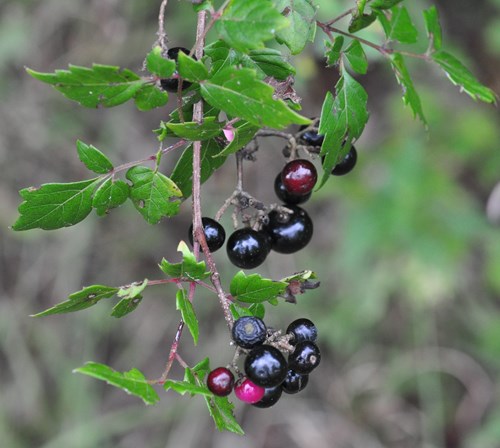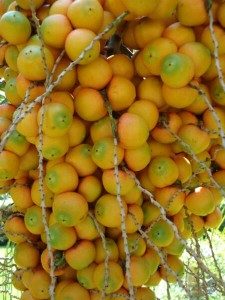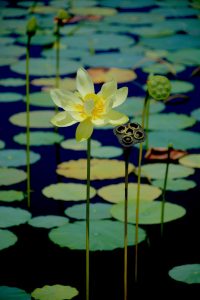
Controversial Peppervine. Is it peppery or tasty?
Putting on black fruit now is the much-debated Peppervine, Ampelopsis arborea. It is closely related to the edible grape but also closely related to the toxic Virginia Creeper. It’s one of those plants that some folks say is definitely toxic and others say definitely edible. My personal experience is that it is not edible, but I know some credible foragers who say they have eating the ripe berries for a long time with no issue. No doubt the problem has to do with annual calcium oxalate production. Peppervine (so-called because the fruit can give a pepper-like burn) apparently can make little to a lot of the chemical each year, varying greatly. Another possibility is method of preparation. It might be that when the berries are juiced and the juice is allowed to set in a cold environment that acid precipitates out leaving useable juice. That is not a fact, but rather speculation on my part. Lacking any definitive information it is a fruit best avoided unless you know for certain your fruit is edible. If you do experiment let me know. I tried some this weekend in Leesburg, Florida. They were sweet at first but within a minute there was a mild burn.

Not Quite Ripe Jelly Palm Fruit
Also seen this weekend is a fruit I have to restrict myself or I will just eat too many I like the flavor so much. Pindo Palms, which can grow as far north as Washington DC, have a long fruiting season. When it starts is always a bit iffy. Around Memorial Day is as good as any date. Of all the palm fruit I have ever tried Pindo is way above the rest. I am surprised it is not a commercial fruit. In fact in my capacity as a consultant for Bacardi I recommended they explore the fruit for distilling purposes. It already has a long history of being used for wine As mentioned in previous newsletters I do not have a sweet tooth but Pindo Palm fruit is one of those delicious exceptions that I have to restrict myself with. If you do make Pindo wine that wine will never clear because of the pectin content of the fruit. However, that same pectin also helps make the fruit into jelly hence the species’ other name, Jelly Palm. You can read about the Pindo Palm here.

Classes are held rain or shine.
Foraging classes this coming weekend range from Orlando to Gainesville. Blanchard Park offers a nice variety in suburbia. Boulware Springs usually has some interesting settlement plants and mushrooms.
Saturday, August 4th, Blanchard Park, 10501 Jay Blanchard Trail, Orlando, FL 32817. 9 a.m. Meet at the pavilion east of the tennis courts near the YMCA.
Sunday, August 5th, Boulware Springs Park, 3420 SE 15th St., Gainesville, FL 32641. Meet at the picnic tables next to the pump house. 9 a.m.
Saturday, August 11th, Dreher Park, 1200 Southern Blvd., West Palm Beach, 33405. As this is the hot summer time do you want to meet at 8 a.m.? Just north of the science center.
Sunday, August 12, Wickham Park, 2500 Parkway Drive, Melbourne, FL 32935-2335. Meet at the “dog park” inside the park, 9 a.m.
Saturday, August 18th, Wekiva State Park, 1800 Wekiwa Circle, Apopka, Florida 32712. There is a park admission Fee: $6 per vehicle. $4 for a single occupant vehicle, $2 pedestrians or bicyclists. Meet at the Sand Lake parking lot (after you pay pass the parking lot on your left then turn left at the Y. Go to the end. This is a rustic walk, no water, no bathrooms, and a hot time of year. The class is three hours or less.) I recommend you arrive early as the park fills with bathers.
Sunday August 19th, Eagle Park Lake, 1800 Keene Road, Largo, FL33771. 9 a.m. Meet at the pavilion near the dog park.
Monday, August 27th, 1624 Taylor Road, Honea Path, South Carolina. Ever want to meet Green Deane but he never seems to come to your neck of the woods? Then mark Monday, August 27th, on your calendar. Green Deane will have a free foraging class in Honea Path, South Carolina, at the Putney Farm, 1624 Taylor Road. The foraging begins at 10 a.m., rain or shine (except hurricanes.) All of Green Deane’s classes are hands on, walking outside. Wild edible plants, medicinals and perhaps a mushroom or two will be on the agenda (as Green Deane is in the Carolinas that week studying local mushrooms.) Donations to Putney Farm are appreciated as they are hosting the event. For more information you can contact Putney Farm on Facebook or Green Deane at GreenDeane@gmail.com.
 Yellow ponds, that’s how I think of it, or in some places, yellow rivers. That’s because the American Lotus is still in blossom. The first time I saw a small lake of these blossoms was when an old dry lake was deepened for a housing development. The next spring suddenly what was for decades a dry lake was full of American Lotus blossoms. This is because the seeds can stay viable some 400 years, or so the experts report. Talk about a survival food! There are multiple edible parts on the American Lotus but I prefer the seeds. I also think when collecting by hand the seeds proved to be the most calories for the amount of work. The roots are edible but digging them up can be a messy, laborious job. Locally American Lotus are easy to find: Just look for a lake with large yellow blossoms on long stems. Further north and west they are a favorite sight on rivers such as the Mississippi. In some places you have to have a special permit to harvest a few. In other areas it’s nuisance species that clogs waterways. So know you local laws. To read more about the American Lotus go here.
Yellow ponds, that’s how I think of it, or in some places, yellow rivers. That’s because the American Lotus is still in blossom. The first time I saw a small lake of these blossoms was when an old dry lake was deepened for a housing development. The next spring suddenly what was for decades a dry lake was full of American Lotus blossoms. This is because the seeds can stay viable some 400 years, or so the experts report. Talk about a survival food! There are multiple edible parts on the American Lotus but I prefer the seeds. I also think when collecting by hand the seeds proved to be the most calories for the amount of work. The roots are edible but digging them up can be a messy, laborious job. Locally American Lotus are easy to find: Just look for a lake with large yellow blossoms on long stems. Further north and west they are a favorite sight on rivers such as the Mississippi. In some places you have to have a special permit to harvest a few. In other areas it’s nuisance species that clogs waterways. So know you local laws. To read more about the American Lotus go here.

Green Deane DVD Set
All of Green Deane’s videos available for free on You Tube. They do have ads on them so every time you watch a Green Deane video I get a quarter of one cent. Four views, one cent. Not exactly a large money-maker but it helps pays for this newsletter. If you want to see the videos without ads and some in slightly better quality you can order the DVD set. It is nine DVDs with 15 videos on each. Many people want their own copy of the videos or they have a slow service and its easier to order then to watch them on-line. They make a good gift for that forager you know. Individual DVDs can also be ordered. You can order them by clicking on the button on the top right of this page or you can go here.

Green Deane Forum
Want to identify a plant? Need to identify a plant? Looking for a foraging reference? Maybe you have a UFO, an Unidentified Flowering Object, you want identified. On the Green Deane Forum we — including Green Deane — chat about foraging all year. And it’s not just about warm-weather plants or just North American flora. Many nations share common weeds so there’s a lot to talk about. There’s also more than weeds. The reference section has information for foraging around the world. There are articles on food preservation, and forgotten skills from making bows to fermenting food. Topics have included: Tea, Salt and Amla, Small Bush and Flower, Ragweed? Pine Cough Drops and Needles, Odd Vine? Hunting and Trapping Ethics. Knife Accidents. Some Kind of Lespendeza and Survival Garden. You can join the forum by clicking on the button in the menu line.
This is weekly issue 315. There will be no newsletter August 28, 2018. I will be in the Carolinas studying mushrooms.
If you would like to donate to Eat The Weeds please click here. Or you can use my Go Fund Me link, or by writing to Green Deane POB 941793 Maitland FL, 32794.
Where the food is
There is little doubt that man has been foraging for food for a long time. As one might guess, in different places he foraged for different plants. He also foraged before there were cities and suburbia. Foraging continued well into the 1900’s, and of course, selectively today.
 Among the challenges of teaching foraging is finding suitable sites. In my classes I tend to visit the same areas, at least four times a year, usually more often. Almost all of these sites are in suburbia, not in the wild. This surprises people because they assume wild food is out in the wilderness. When the famous Willie Sutton was asked why he robbed banks, he supposedly said “because that’s where the money is.” I teach foraging in suburbia because that’s where the plants are. It’s also where the people are.
Among the challenges of teaching foraging is finding suitable sites. In my classes I tend to visit the same areas, at least four times a year, usually more often. Almost all of these sites are in suburbia, not in the wild. This surprises people because they assume wild food is out in the wilderness. When the famous Willie Sutton was asked why he robbed banks, he supposedly said “because that’s where the money is.” I teach foraging in suburbia because that’s where the plants are. It’s also where the people are.
That said, I have to qualify that comment. There are edibles in the wilds, but they tend to be different than those found in population centers and represent more a subsistence living than variety. Many edible weeds, perhaps the majority, are not native. They are from somewhere else. They came with humans and humans went to population centers. They spread out a bit from there but in density suburbia is ground zero.
In an old city park I can usually find 60 to 100 edible species and I usually have to walk only a mile or so. In a state park I can walk 10 miles and find perhaps 20 edible species. This is not to say native food is inferior or rare. It is better to say the choice is limited. But when you combine native and imported plants (and edible ornamentals) then one has a much larger menu in suburbia, which is conveniently where the people live. (In agricultural areas, farm land substitutes for suburbia. Read where man is active there are weeds.)
The other reason I use city parks is because most of the species we find there most folks can also find in their own yard or neighborhood. It’s good to learn what the natives ate to survive but most folks want to find food around their own home, not a distant state park (where foraging is often illegal.)
Foraging in suburbia does raise the issue of pollution, and that has to be taken into consideration. Despite that complication foraging in suburbia is where more people forage today. It is where most people find their wild food, and that is where I teach the most. Willie Sutton would understand.
(By the way, what Sutton really said was: “Why did I rob banks? Because I enjoyed it. I loved it. I was more alive when I was inside a bank, robbing it, than at any other time in my life. I enjoyed everything about it so much that one or two weeks later I’d be out looking for the next job. But to me the money was the chips, that’s all.“


I have eaten the PEPPER VINE fruit several times and like the taste. I usually limit myself to about 5 or 6 berries though, since you give them a warning label. Now the PINDO PALM is another story. When I first learned about them several years back, I would eat a bowl full of fruit for breakfast several times a week (while they were in season, which was a long time). I loved them so much, after 2 or 3 years, I realized they were wearing out the enamel on my teeth! I should have remembered MODERATION, and all would have been well. Today, I only eat a few every year, and I try to follow them with other food that will wash away the acid. I still LOVE those things though! Only my love for loquats and Jesus is greater!
Dean, thanks for the newsletter.
A few years ago, I popped one peppervine berry in my mouth. I had read that so many say it is edible I wanted to squish it in my mouth to see if it gave any bad sensations. I don’t remember the taste that much, just that it was tolerable. I spit the juice out because I didn’t want to risk any negative effects. What I do remember is that within a few seconds it made the back of my tongue and throat numb. The numbness lingered for a while and them dissipated. It was unpleasant. I have no desire to experiment further with peppervine, even though it spreads like crazy in my back yard.